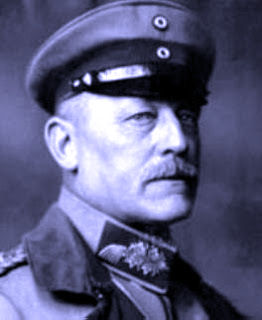 |
| Montfaucon– First Day Objective of the 79th Division |
Many books about the Great War have concentrated on single battles, but only a few on single units, in this case a National Army division formed in 1917. Gene Fax, an engineer who researched antisubmarine warfare for the U.S. Navy and environmental issues, spent 17 years (according to his bio) writing about his grandfather’s division, the 79th. With Their Bare Hands was well received when it came out, winning accolades and awards on excellent reviews.
Like many works of its kind, Fax spends a good part of his text on background, both of the war in Europe and the United States, on Pershing and on the area where the 79th originated, around Washington DC; Baltimore, Maryland; and Philadelphia, Pennsylvania. It’s part social history, part military history, and part careful analysis of what went into the 79th.
 |
| Approach to Montfaucon Today |
The prologue is entertaining, if not enlightening. It depicts a division runner who speaks the truth about his late mission: he can’t say that the brigade commander knew where his brigade was…and they sent him to find him again. This second mission was more adventurous but less successful. As an example of what was to follow, it is entirely apt. The first five chapters show how getting 18,000 men together in a training camp and getting them all to work together with practically no equipment, few trainers, a changing/developing training program, and constant pressure to get ready to go overseas is much like herding cats.
 |
| Wounded Men of the 79th Division |
The strength of Fax’s analysis is clear early in the book. He doesn’t pull many punches, and seems perfectly at home poking derision at Pershing and the Army for its lack of preparedness. Early on, he dismisses most general officer memoirs as myopic and self-justifying. While true and refreshing, this sentiment is not generally accepted by historians, and more’s the pity. In this reviewer’s own books, especially on the American Civil War, there is no assumption that memoirs and letters are unimpeachable sources, approaching them with a critical mindset.
Once the 79th gets to France, confusion sets in for good. Their artillery brigade goes off to train on its own, never to return…not that it matters much. Once committed to the Meuse-Argonne, AEF sent the division staff off to train somewhere else. Assigned to take the “weak position” called Montfaucon on the first day, the 79th struggles and bleeds and dies and takes ground literally with their bare hands, with little or no support from nearby units and no organic artillery, which they were barely trained to work with, in any event. When the 79th finally secures Montfaucon, it feels anticlimactic.
A minor quibble this reviewer has with the otherwise excellent narrative is that Fax mentions the BAR and Browning heavy machine guns the 79th uses only in passing. The 79th was one of the few units to receive the Browning weapons, yet Fax omits Pershing’s reluctance to issue them at all. Pershing had possibly legitimate concerns that if the Germans were to capture a BAR, which they did not possess in their arsenal, they might replicate it to the detriment of the Allies. While that fear showed that Pershing did not see the war ending as fast as it did, we could also forgive him for not knowing how long it took the Germans to develop anything at all. As for the .30 caliber Browning MG, using it made the 79th one of the few ammunition-homogenous divisions in the AEF. Perhaps the distinction had little function in the event, but it is worth mentioning.
In subsequent chapters, we see the 79th driving ever on with few replacements, lousy staff work, poor casualty evacuation, and the eternally grinding successes the 79th could make on the battlefield. At the end of the war, the transportation home and the demobbing processes are a unique glimpse at something no one else cares much about.
In all, With Their Bare Hands is a well-written microscope view of a National Division, likely typical of the breed. While the author had a personal connection with the outfit, that connection does not seem to color the narrative or the analysis. The maps in With Their Bare Hands are an asset. Contour maps can be confusing even for the old soldier, but the way Fax rendered these makes them perfectly lucid. With Their Bare Hands, as the reviews showed, is an outstanding addition to our corpus of knowledge of the AEF and the Meuse-Argonne offensive.
John D. Beatty





































